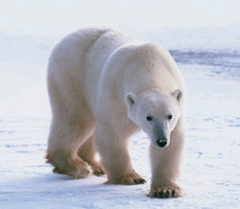Emerging Science Note Polar Bears
Air Date: Week of September 25, 2009

(Courtesy of USGS)
Inuit trackers can trace polar bears based on a single paw print, and DNA technology can identify individual bears. Lisa Song reports on biologists who combine both methods to monitor bear populations.
Transcript
YOUNG: ItÂ’s Living on Earth. IÂ’m Jeff Young.
CURWOOD: And IÂ’m Steve Curwood. Just ahead, a sad phenomenon in the Pacific Northwest, but first this note on emerging science from Lisa Song.
[THEME MUSIC]
SONG: As climate change thaws the Arctic, itÂ’s more important than ever to keep an eye on polar bears. Scientists are now turning to Inuit expertise to monitor bear populations. For Inuit hunters, a single paw print can reveal a polar bear's sex, age, and size. The expert trackers will help researchers study polar bear movements and the accuracy of those skills will be tested by Canadian scientists.
At the same time, scientists will build fences around pieces of meat used as bait. As polar bears dine on the meat, bits of fur will get trapped on the fence, and biologists can use DNA markers from the hair to identify individual bears. Bear droppings will also be collected to study for signs of disease.

(Courtesy of USGS)
Currently, researchers follow bears in helicopters and inject them with tranquilizers before tagging the animals for study. The new system is cheaper and more humane. It also helps economic development. The Inuit hunters will work from cabins in the far north, close to Baffin Island. When not being used for research, the cabins can be rented by eco-tourists.
Scientists hope that this combination of traditional skills and DNA technology will be used to create a map of polar bear behavior and migration - a census of the great carnivores in a world of warming ice. ThatÂ’s this weekÂ’s Note on Emerging Science. IÂ’m Lisa Song.
[THEME MUSIC]
Living on Earth wants to hear from you!
Living on Earth
62 Calef Highway, Suite 212
Lee, NH 03861
Telephone: 617-287-4121
E-mail: comments@loe.org
Newsletter [Click here]
Donate to Living on Earth!
Living on Earth is an independent media program and relies entirely on contributions from listeners and institutions supporting public service. Please donate now to preserve an independent environmental voice.
NewsletterLiving on Earth offers a weekly delivery of the show's rundown to your mailbox. Sign up for our newsletter today!
 Sailors For The Sea: Be the change you want to sea.
Sailors For The Sea: Be the change you want to sea.
 Creating positive outcomes for future generations.
Creating positive outcomes for future generations.
 Innovating to make the world a better, more sustainable place to live. Listen to the race to 9 billion
Innovating to make the world a better, more sustainable place to live. Listen to the race to 9 billion
 The Grantham Foundation for the Protection of the Environment: Committed to protecting and improving the health of the global environment.
The Grantham Foundation for the Protection of the Environment: Committed to protecting and improving the health of the global environment.
 Contribute to Living on Earth and receive, as our gift to you, an archival print of one of Mark Seth Lender's extraordinary wildlife photographs. Follow the link to see Mark's current collection of photographs.
Contribute to Living on Earth and receive, as our gift to you, an archival print of one of Mark Seth Lender's extraordinary wildlife photographs. Follow the link to see Mark's current collection of photographs.
 Buy a signed copy of Mark Seth Lender's book Smeagull the Seagull & support Living on Earth
Buy a signed copy of Mark Seth Lender's book Smeagull the Seagull & support Living on Earth

